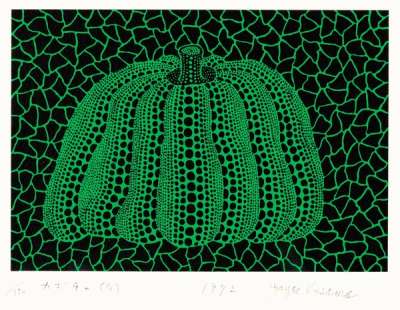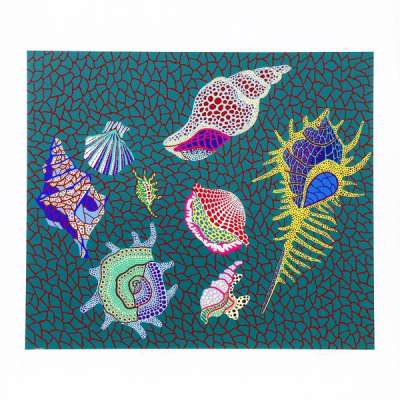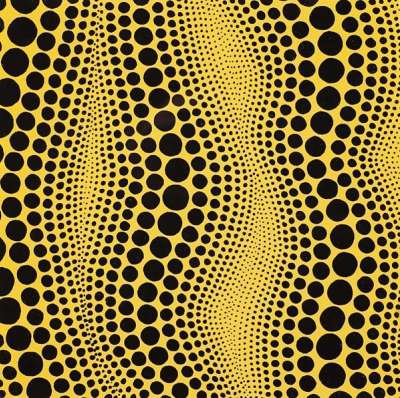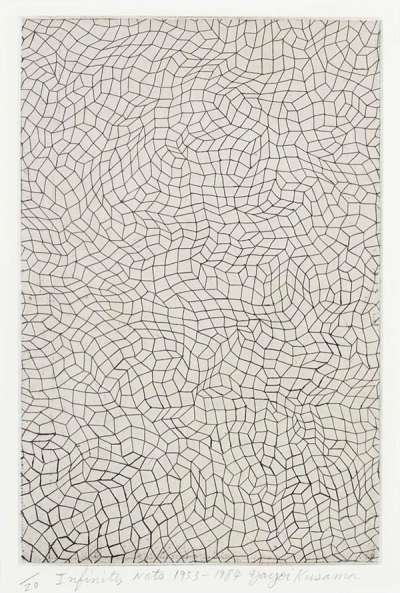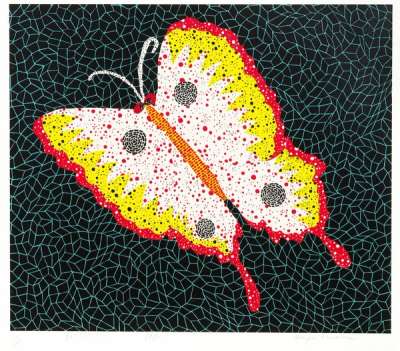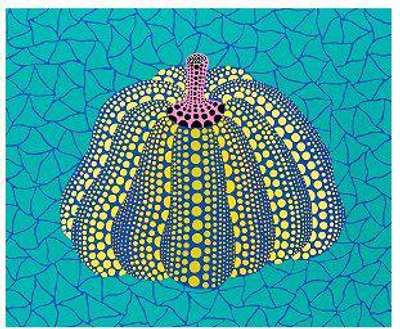 Butterfly, Kusama 81 © Yayoi Kusama 1985
Butterfly, Kusama 81 © Yayoi Kusama 1985
Yayoi Kusama
290 works
In the world of contemporary art, Yayoi Kusama emerges as a distinctive and unique voice. Through her paintings, sculptures, and immersive installations, Kusama has showcased an exploration of obsession, self-representation, and the infinite. Her iconic polka dots, mirrored rooms, and expansive pumpkin motifs aren't only visually arresting—they offer insights into the mind of an artist who challenges conventions. Navigating Kusama's universe is an invitation to understand the narratives and cultural dialogues that have influenced her journey.
A is for Avant-garde
Kusama, born in 1929, emerged in post-war Japan as a pioneer of the avant-garde movement, breaking barriers in both art and society. Her creations, which encompass diverse mediums from painting to sculpture, epitomise the avant-garde's spirit, pushing boundaries and redefining conventions.
B is for the Best Exhibitions
Kusama's career has graced many international platforms, but some exhibitions stand out. The 1966 Venice Biennale saw her captivating Narcissus Garden challenge art commercialism. Fast-forward to the 2000s, museums like MoMA and the Tate Modern hosted retrospectives, rekindling global Kusama-mania.
C is for Cosmic
Central to Kusama's work is her fascination with the cosmos. Infinity rooms like The Souls of Millions of Light Years Away invite viewers to immerse in an endless celestial expanse. This recurring cosmic theme, often accompanied by polka dots, poses profound questions. Is it a reflection of Kusama's own mental health struggles, where she’s expressed feeling obliterated by endless dots? Or perhaps a grander commentary on our place in the universe?
D is for Dots
Arguably Kusama's most recognizable motif, her polka dots transcend mere design. Beginning in her childhood, these dots became symbols of the hallucinations she experienced. Over decades, they've evolved to embody themes of infinity, self-obliteration, and the interconnectedness of the universe.
 Image © Louis Vuitton / Bella Hadid Modelling Yayoi Kusama for Louis Vuitton 2023
Image © Louis Vuitton / Bella Hadid Modelling Yayoi Kusama for Louis Vuitton 2023E is for Ephemeral
Kusama's works often embrace the fleeting nature of life and art. This is evident in her Obliteration Room, where the initially pristine white environment gradually transforms as visitors add colourful stickers. How does one experience the nature of existence through Kusama's lens? Her installations answer this question by evolving with audience participation, symbolising the transitory moments that construct our lives.
F is for Fashion
Fashion, like art, is an avenue for self-expression, and when Yayoi Kusama married her distinctive style with the high fashion world of Louis Vuitton, it was a merger of iconoclasts. Kusama's signature polka dots swathed the luxury brand's products, transforming them into covetable pieces of art. From handbags to ready-to-wear clothing, this collaboration echoed the timeless allure of Kusama's motifs, merging her out-of-the-box sensibilities with the brand's luxury ethos.
G is for 'Give Me Love'
Kusama's 2015 exhibition, Give Me Love, displayed in New York's David Zwirner gallery, showcased her iconic dotted pumpkins and the mesmerising Obliteration Room. The show was a vivid reminder of her style; vibrant hues and patterns. A reflection of her psyche, Kusama uses these elements to express both individual and universal experiences of obsession and repetition.
H is for Happenings
During the 1960s, Kusama organised a series of performances called Happenings. These often provocative events, set in iconic locations like Central Park, challenged societal norms and taboos. They highlighted the era's zeitgeist, reflecting calls for freedom and rebellion against conventions.
I is for Infinity
One of Kusama’s most renowned series, the Infinity Mirrored Rooms encapsulate her obsession with the concept of infinity and her ongoing exploration of the self. These immersive installations invite viewers into a kaleidoscopic space, challenging perceptions of reality. Originating in the 1960s, these rooms not only convey Kusama's vision of the universe's vastness but also illuminate the introspection of her psyche among it.
J is for Japan
Born in 1929 in Matsumoto City, Japan, Kusama's early experiences in her native country deeply influenced her artistic trajectory. From her childhood amidst the backdrop of World War II to her initial forays into Japanese Nihonga painting, her roots are ever-present in her works.
K is for Kusamatrix
In 2004, Tokyo’s Mori Art Museum held a comprehensive exhibition titled Kusamatrix. This exhibit reinvigorated Kusama’s presence in the contemporary art world and introduced her to a younger generation. Showcasing her brilliant compositions, it embraced both her older iconic pieces and newer post-2000 creations.
L is for Love Forever
Love Forever marked a pivotal phase for Kusama where she began confronting themes of love, death, and eternity. Defined by her signature polka dots, these monochromatic works often utilise repetition, emphasising her fascinations and anxieties. Love itself follows a pattern of ebbs and flows. Kusama's exploration suggests that in a universe as infinite as her mirrored rooms, the endurance of love is equally profound.
This exploration of love and infinity continues in her recent works, such as those showcased in her fourteenth solo exhibition at the Victoria Miro Gallery in London. Titled Every Day I Pray for Love (2024), the exhibition featured her latest series of paintings and sculptures, alongside a new Infinity Mirrored Room - Beauty Described by a Spherical Heart. Through this exhibition, Kusama expands on her lifelong meditations on love’s boundlessness and its intricate interplay with themes of self-reflection and eternity.
M is for Minimalism
In the heart of New York's art scene, Kusama's works displayed a fascinating flirtation with Minimalism. While her immersive environments and polka-dotted landscapes often steal the limelight, her lesser-known, minimalist paintings offer a stark contrast. These pieces, characterised by their planes of singular colours, are juxtaposed by delicate patterns or textures. Kusama skillfully blends self-expression with abstraction, providing an insight into how minimalism fits into her overall artistic journey.
N is for New York
The 1960s saw Kusama's migration to New York, a move that would be pivotal in her career. Here, she mingled with the city's experimental scene, befriending artists like Donald Judd and Eva Hesse. While New York provided artists a land of opportunity, it was also a place of struggle for Kusama. It was in this backdrop that she forged her signature works, solidifying her position during an era that was pivotal to both her artistic evolution and her legacy.
O is for Obsession
Obsession is a recurring motif in Kusama's work. From her polka dots to her Infinity Nets, there's an underlying thread of compulsiveness and repetition. Stemming from her personal challenges, including hallucinations and neurosis, her art transforms these struggles into a universal exploration of obsession and identity. By immersing viewers in her psyche's patterns, she bridges the personal with the universal.
P is for Pumpkins
Initially introduced to them in her family's seed nursery, they became a symbol of comfort and nostalgia for the artist. Beyond personal sentiment, the organic, bulbous form of the pumpkin is a canvas for Kusama’s repetitive patterns, merging her signature style with an object that holds deep autobiographical significance. But why pumpkins? They embody growth, resilience, and life's cyclical nature in Kusama's vision.
Q is for Quantum Leap
Kusama's process has been marked by significant evolutions,shifting from painting to sculpture, and then to immersive installations. This adaptability gave birth to collections like Hats, Butterflies, and Flowers. It’s this innate ability to transcend mediums that highlights her relentless pursuit of exploring the infinite, not just in her personal life, but in her art.
R is for Retrospectives
Kusama's influence on contemporary art is evidenced by the numerous retrospectives dedicated to her work. Notably, the Tate Modern in London and the Whitney Museum in New York have celebrated her legacy with major exhibitions. These retrospectives not only highlight her extensive oeuvre but also demonstrate the timeless appeal of her vision, captivating audiences across generations and continents.
S is for Self-Obliteration
Self-obliteration is a recurring theme in Kusama's work, where she uses dense patterns to make objects, and even herself, merge with the environment. This can be seen in her pumpkin sculptures and polka dot installations. Beneath this theme lies an exploration of identity and ego, suggesting that self-obliteration might be Kusama's response to humanity's timeless desire to comprehend our position within the universe.
T is for Tactile
Kusama's works often engage the viewer's sense of touch, even if only imagined. From the soft, protruding tuber-like forms of her Accumulation sculptures to her acclaimed infinity rooms, there's an undeniable urge to reach out and experience her art tangibly. This physical element of her works deepens Kusama's engagement with her audience, forging a dynamic relationship between the art, its environment, and the observer.
U is for Unwavering Persistence
Throughout Kusama's extensive artistic career, one thing remains clear: her unwavering persistence. Born in 1929, Kusama overcame early family adversity and cultural constraints, only to relentlessly pursue her visions in a predominantly Western and male-dominated art world.
V is for Vulnerability
Kusama's works often reflect her vulnerabilities, especially her lifelong struggle with mental health. This struggle became a transformative power, giving birth to some of her top performing works and obsessive patterns. Through her art, she candidly offers a glimpse into her world of neuroses, proving that her vulnerabilities can be channelled into potent creative forces.
W is for World Records
In 2014, one of Kusama's pieces, White No. 28, fetched a staggering $7.1 million at an auction, marking her as one of the most expensive living female artists. This milestone is more than just a testament to her talent—it reflects the contemporary art market's appreciation for non-Western and female perspectives.
X is for Flower XL
Within Kusama’s boldly coloured collection of flowers, viewers will find a monochromatic, black and white composition in Flower XL that’s equally impressive. Kusama’s colour palette certainly proves that even with a void of colour, her work can stand on its own, without relying on a variety of hues to convey. the same level of depth or emotion.
Y is for Yayoi
Yayoi’s life, marked by a journey from post-war Japan to New York City's vibrant art scene of the '60s, tells a story of resilience, innovation, and relentless dedication. Against the backdrop of these transformative years, she cultivated a style that was uniquely her own, blending traditional Japanese influences with avant-garde Western concepts. Her works, characterised by obsessive patterns and visions, have not only broken aesthetic boundaries—they've also transcended cultural and generational divides, captivating audiences from all walks of life.
Z is for Zenith
Kusama's trajectory has always been upward, reaching unparalleled heights in the realm of contemporary art. The fervour around her exhibitions, spanning cities like Tokyo and New York, showcases more than just her popularity—it underscores a lifetime of innovation and evolution. This zenith symbolises not just her position in the art world, but also the culmination of her vision and the resonance of her message.















